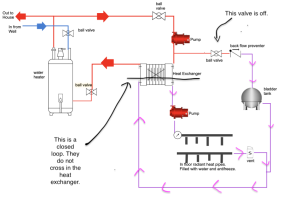AFinePilsner1
New Member
Hi gang. I'm proactively replacing my 21 year old Lochinvar (giddy up). I have attached an image of my current hot water and hydronic floor heat setup. Basically, the original installer mixed a top discharge with a side return instead of doing both at the top or both on the side. It really is an elegant system though and has worked flawlessly and cheaply all these years. I know, right!
I am curious about how the standard heat trap nipples on the new water heater will work with my closed loop hydronic heating system. I have lots of trade skills, but managing the thermodynamic properties of water is not one of them. Here are my options:
1. I could install the new water heater the exact same way. My fear is that the heat trap on the top cold water inlet might function like a partial check valve though. I wonder if the cold water heat trap on the inlet will cause some strange back pressure build up as the new cold water competes with the returning warm water.
2. I could make the warm water return to the top on the cold water side just after the inlet ball valve. I hope that someone can confirm though that putting the return line there will not cause a back flow problem. [Please note that the manufacturer install image does NOT show a check valve and expansion tank at that connection. This topic was debated on a different discussion board https://www.plbg.com/forum/read.php?1,294601.]
3. I could remove those heat traps from both inlet nipples and run the new water heater just like the last one. They just pop out. I am sure there is heat loss, but the system seems to work well now.
So, what would you guys do if this were your house?
PS- While I have your attention, that ball valve on the automatic system refill on the closed loop hyrdonic section (see image) should probably be off and turned on once a year before heating season or if I ever notice a pressure drop. However, please notice that there is little bit of pipe after it and before the backflow preventer. In my mind, water can trap and stagnate there all year and then enter my water heater when I turn it on to top off, so I had been leaving it on. Shouldn't that technically be an all-in-one Watts combo there or something else? I think the original plumber improvised. Please note: There is a heat exchanger to separate the systems.
I am curious about how the standard heat trap nipples on the new water heater will work with my closed loop hydronic heating system. I have lots of trade skills, but managing the thermodynamic properties of water is not one of them. Here are my options:
1. I could install the new water heater the exact same way. My fear is that the heat trap on the top cold water inlet might function like a partial check valve though. I wonder if the cold water heat trap on the inlet will cause some strange back pressure build up as the new cold water competes with the returning warm water.
2. I could make the warm water return to the top on the cold water side just after the inlet ball valve. I hope that someone can confirm though that putting the return line there will not cause a back flow problem. [Please note that the manufacturer install image does NOT show a check valve and expansion tank at that connection. This topic was debated on a different discussion board https://www.plbg.com/forum/read.php?1,294601.]
3. I could remove those heat traps from both inlet nipples and run the new water heater just like the last one. They just pop out. I am sure there is heat loss, but the system seems to work well now.
So, what would you guys do if this were your house?
PS- While I have your attention, that ball valve on the automatic system refill on the closed loop hyrdonic section (see image) should probably be off and turned on once a year before heating season or if I ever notice a pressure drop. However, please notice that there is little bit of pipe after it and before the backflow preventer. In my mind, water can trap and stagnate there all year and then enter my water heater when I turn it on to top off, so I had been leaving it on. Shouldn't that technically be an all-in-one Watts combo there or something else? I think the original plumber improvised. Please note: There is a heat exchanger to separate the systems.
Attachments
Last edited:

